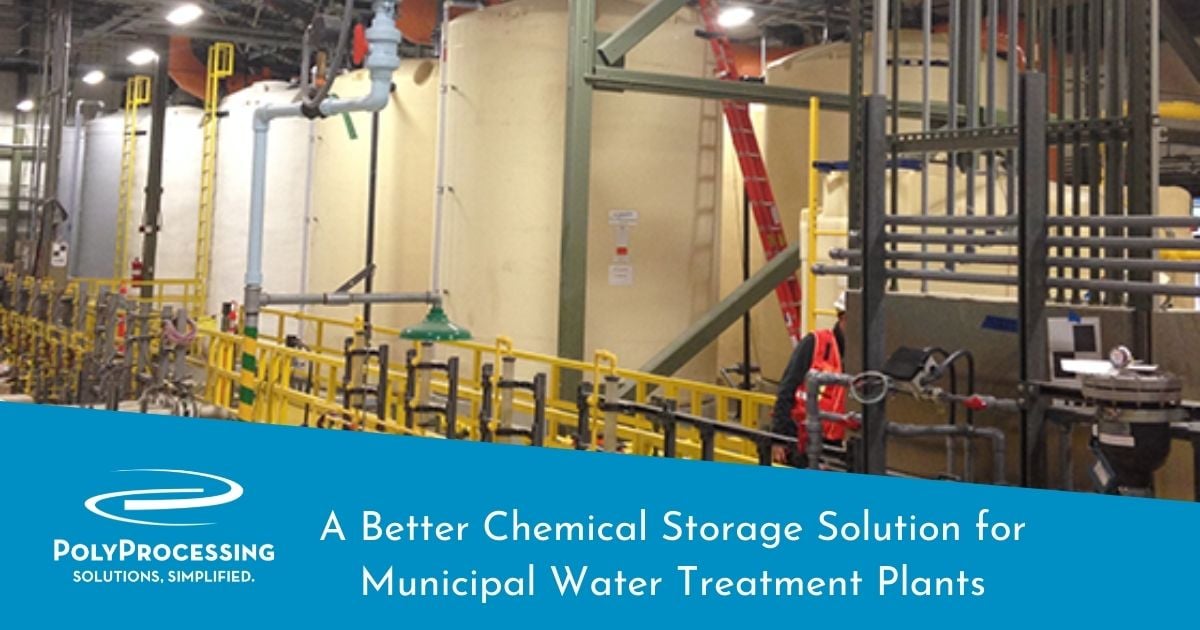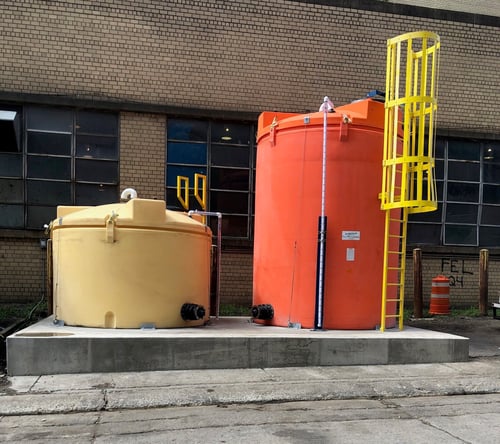A Better Chemical Storage Solution for Municipal Water Treatment Plants
It’s common for wastewater treatment plants to rely on cross-linked polyethylene chemical tanks, but many municipal water treatment plants are using inferior linear polyethylene or fiberglass tanks. While the short-term benefits are tempting, using linear polyethylene or fiberglass tanks can be like pouring money down the drain. Instead, Poly Processing’s cross-linked polyethylene (XLPE) tanks give you better performance, greater cost-effectiveness, longer useful life, and more innovative solutions.

Don’t All Tanks Perform the Same?
XLPE storage tanks play a key role in municipal water treatment plants. You may not be storing the volume of hazardous chemicals that a wastewater plant uses, but you are containing harsh materials that attack fiberglass and linear polyethylene tanks. These chemicals require a strong, safe storage solution to combat their corrosive properties—but not all tanks are made equal.
Fiberglass
Fiberglass storage tanks aren’t one-piece vessels, which means they contain seams. Each seam can be a weak point, creating opportunities for leaks and possible premature failure. Fiberglass tanks can also be handcrafted, or hand laid up, which opens up several opportunities for human error. In addition to the quality issues, fiberglass is expensive - and corrosion barriers for aggressive chemicals can increase these costs significantly. All these challenges mean you need to continually maintain fiberglass tanks and be vigilant to inspect for wicking and leaks.
Linear Polyethylene
Linear polyethylene tanks are created when thermoplastic resin is heated to create a fluid plastic that will harden and cure into a linear, high-density polyethylene surface. The molecules are connected like a rope—the individual threads of fiber are twisted together, but not tied.
Linear polyethylene tanks in general are cheaper due to the material costs and molding parameters. For certain storage applications such as water storage, these tanks can do the job nicely. Due to the lower upfront costs, many municipal water plants use linear polyethylene tanks. Linear polyethylene is less expensive than fiberglass, but it’s also susceptible to corrosion and requires regular maintenance throughout the reduced useful life of the tank.
Cross-linked Polyethylene
Cross-linked polyethylene meets each of these challenges. Because of its seamless one-piece molded construction, polyethylene storage tanks lack seams where leaks tend to develop. The material is also resistant to corrosion, which means maintenance is practically eliminated throughout the increased useful life of the tank. XLPE tanks are also manufactured by an automated process, eliminating the risk of human error. Due to lower cost of materials and expense of the manufacturing process, Poly’s XLPE storage tanks are lower cost than fiberglass storage tanks.
XLPE Tanks Provide More Value
When calculating the true cost of a chemical storage tank, consider the cost over the useful life of the product - not merely the upfront cost. That’s where Poly Processing shines. Our tanks are designed to give you the longest life possible out of your chemical storage system.
One of our core values is cost-effectiveness, and that comes out in our tanks’ superior warranties and life expectancies. Our tanks have a much longer life expectancy than other materials. So, while our cross-linked tanks could have a higher upfront cost than some linear polyethylene tanks, the cost over the useful life of the tank is much less.
Our XLPE chemical tanks have a five-year full warranty, with a life expectancy of 15-20 years in most cases. A linear tank’s life expectancy is typically 4-6 years. You’ll get three times as much life out of a cross-linked polyethylene tank for only a slightly higher initial cost.
When it comes to fiberglass, our tanks cost about half the price of a fiberglass tank. They also have a longer warranty, for an even greater cost effectiveness.
Innovative Tank Systems for Your Needs
Poly Processing’s chemical storage tanks are designed to meet the storage needs of municipal water plants. Our innovative solutions help your personnel do their job more effectively, and more safely.
Full-Drain Tanks
The chemicals used in water treatment pose risks of contamination or harm to humans in the event of leaks or spills. Secondary containment is a must. If concrete secondary containment is already in place, Poly Processing’s IMFO tank or Sloped Bottom IMFO tank are the perfect water treatment chemical storage solutions..jpg?width=521&name=IMFO%20with%20Butterfly%20Valve%20and%20PTFE%20Expansion%20Joint%20(3).jpg) Poly Processing’s Integrally Molded Flanged Outlet (IMFO®) Tank, is a homogenous flange system that is molded as part of the tank while it is being manufactured, making it a stress-free part of the tank. The flange is created from the same material as the tank — it’s not an insert added during or post-production. The IMFO offers superior tank strength in a one-piece molded tank, with the flange molded into the lowest part of the tank.
Poly Processing’s Integrally Molded Flanged Outlet (IMFO®) Tank, is a homogenous flange system that is molded as part of the tank while it is being manufactured, making it a stress-free part of the tank. The flange is created from the same material as the tank — it’s not an insert added during or post-production. The IMFO offers superior tank strength in a one-piece molded tank, with the flange molded into the lowest part of the tank.
Double-Wall Containment
If you don’t have adequate secondary containment, our innovative SAFE-Tank System provides an unmatched safe chemical storage solution for water treatment. Poly Processing’s SAFE-Tank®, double wall tank system, is a “tank-within-a-tank” that provides secondary containment to avoid the damaging of equipment or property, loss of chemical, or injury to employees in the event of a spill. The tank is designed to keep contaminants from entering the interstitial space.

Additional Antioxidant Protection
For additional antioxidant protection, IMFO tanks and SAFE-Tanks are available with our OR-1000™ system. Poly Processing’s exclusive OR-1000™ system was specifically designed to address the aggressive oxidation effects of sodium hypochlorite, sulfuric acid, and hydrochloric acid by adding an additional resin system between the XLPE and the chemical. It is designed to maximize the useful life of storage tanks in oxidizing environments. The OR-1000 system consists of engineered resins for oxidizing applications. This system increases the life of a crosslinked polyethylene tank giving the end user a greater cost-effective solution. Poly Processing’s exclusive OR-1000 system addresses the aggressive oxidation effects of the most oxidative chemicals by adding an engineered resin system to the tank.
NSF/ANSI 61 Certification
Currently, we have NSF/ANSI 61 tank system certification for thirty-eight of the most popular water treatment chemicals on our XLPE tank systems. Poly Processing holds the more stringent chemical system certification to make sure we provide the safest tank systems for drinking water safety. We certified the complete system from tank to bolt washers to this strict standard. Additionally, our certifications cover XLPE tanks with the OR-1000™ system, our engineered antioxidant barrier. Poly tanks are certified for both potable water and chemical storage.
The Right Tank System for Municipal Water Plants
When it comes to protecting your equipment, your personnel, and your chemical supplies, cross-linked polyethylene tank systems are second to none. Not only are they the smartest financial investment, they also out perform other tank options for reliability, safety and longevity.
For specific questions about a custom water treatment chemical storage tank system, contact a Poly Processing chemical storage tank specialist today.
- May 9, 2022
- Topics: Tank Design and Materials
About Poly Processing
Posts By Topic
Tech Talk Podcast Episodes
Subscribe By Email
Recent Posts
- Installation Tips for Chemical Storage Tanks: Site Preparation and Offloading
- Understanding pH and Chemical Concentration When Choosing a Chemical Tank
- Maximizing Fill Efficiency: Selecting the Optimal Fill Line System
- Chemical Storage Tanks: A Quick Guide for End Users
- Popular Customization Options for Chemical Storage Tanks
Tank Configurator

Find the recommended tank and system components for your chemical storage challenge.
Configure a Tank Package






